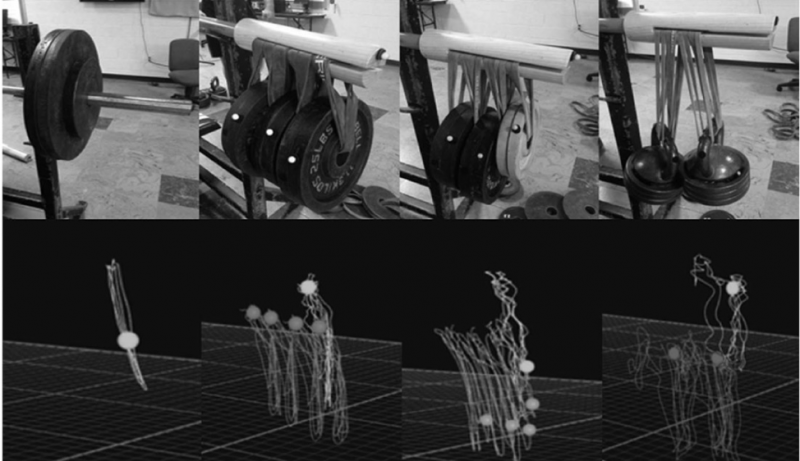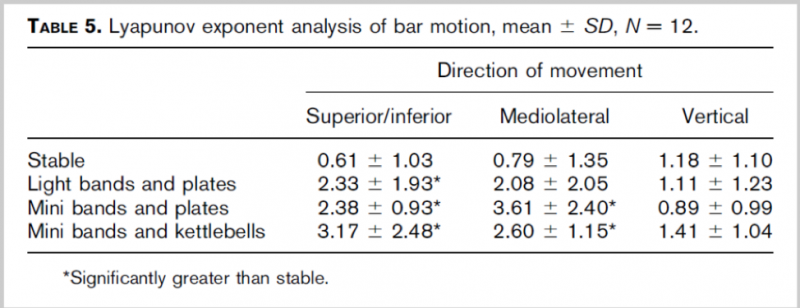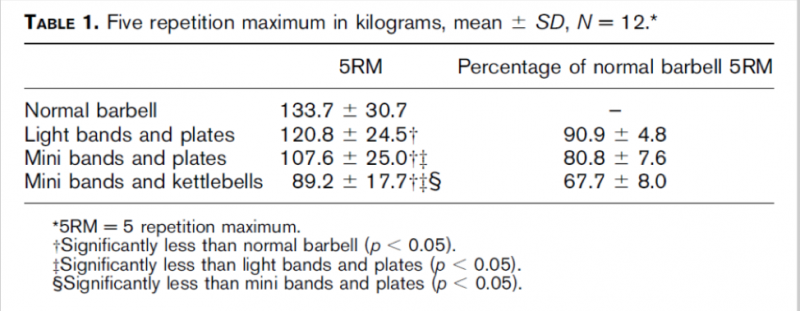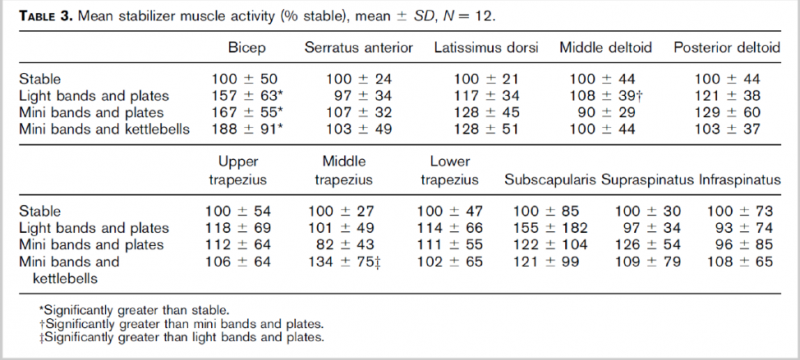
I think it may be fairly well known that I am a fan of unstable load training. I coined this as chaos training in the first edition of the book by Dan Austin and myself: Powerlifting. This sort of training is characterized by having a load that moves during the exercises, causing multiple bar change paths and performed on stable surfaces. This can be done by hanging different loads from a barbell through the use of rubber bands, through the use of specialty bars such as the tsunami bar, or even through the use of a specialty bar such as the earthquake bar and the hanging of either plates or kettlebells via bands.
I like using this method of training in both sport and in powerlifting for two major reasons. For sport, I feel that it better replicates the demands of the game than traditional unstable training does. In sports, excluding aquatic sports, the surface is stable, and the environment is chaotic. When unstable surface training is performed, it is quite the opposite. Although I feel that unstable surface training does have its place in athletic performance, that place falls in the rehabilitation arena. In a study by Cressey et al. {Cressey, 2007 #1348}, they found that when healthy athletes underwent training on unstable surfaces, the reaction time of the proprioceptors actually slowed down. The force interaction with the ground is always very brief, and the force interaction with the unstable surfaces is very slow and delayed. This is great when trying to speed up the engagement of the proprioceptors, as they are not firing optimally due to the previous injury. However, in sports, this becomes an issue. If the engagement of muscle spindle is delayed, this may allow the joint to get out of position to the extent where the muscle can’t appropriately pull it back into position efficiently due to passive insufficiency (meaning that the muscle has elongated to the point where there are not enough active binding sites available to produce a force to allow the contraction to overcome the force placed upon the muscle). This may lead to soft tissue injury or even joint injury. This is a bit comical, as people are doing this sort of training to cause a reduction in injury and they may, in fact, be increasing their risk of it.
RECENT: The Rise of Live Stream Conferences
For powerlifting specifically, the EMG was not very different between the stable and unstable load conditions for the prime movers (although it was statistically significant, it may still be worth the tradeoff), but the EMG for the stabilizer muscles was far greater in the unstable condition {Lawrence, 2018 #1351}. In another study {Ostrowski, 2017 #1349} that used untrained or recreationally trained individuals, there was no difference between the prime movers for the conditions. This indicates that you can get the same prime mover activity with a much lower load (go get the loads to insert here) with the unstable load. This would mean the same muscular stimulus without as much strain on the joints. This is crucial for the older lifter who may have a great number of injuries that preclude him or her from training heavy any longer. For the younger lifter, this may allow him or her not to have injuries that may be incurred through years of heavy lifting.
In a study by Lawrence et al., they examined the bar path of increasingly unstable loads as seen here in Figure 1, taken from the article. As can clearly be seen on the left, in the stable load, there was very little variation in the bar path, starting, touching, or ending position for the bench press. In the second-from-the-left condition, performed with the earthquake bar and thick bands, there was a significant alteration in the bar path between repetitions in terms of touch point, yet the pressing was fairly straight on each repetition. In the third condition of the earthquake bar with plates with thinner bands (mini bands, presumably), the bar path starts off smooth and starts to have some greater displacement from the path with each subsequent repetition. In the final condition of the earthquake bar plus thin bands and kettlebells, there was no white visible on the graph. This indicates that no two repetitions went in the same path; the path chart resembles chicken scratch. There was a marked instability in this condition. In what was marked in the study as Table 5, we see the numerical expression for the congruence of the repetitions. This shows not just the anterior posterior and superior inferior (bar movement toward the face and hips as well as vertical difference), but a medial lateral movement as well (from side to side). The fourth conditioning showed more than five times the variability in the repetitions as the stable load.
Table 1 below shows just how much of a decrease there was with each unstable condition, with the final condition requiring only 67% of the 1RM of the stable bench press. Reducing the load by a full third while maintaining the same effort from the individual and a greater taxing of the stabilizer muscles may allow for the body to more completely heal and recover between training bouts. Personally and anecdotally, after I reached the age of 33, I only saw consistent progress in my lifts if I rotated dynamic effort, maximum effort, and unstable loads in training.
For the athletes, the stabilizer muscles may be just as important, as they are what is going to be most active during the movements on the field. The ability to decelerate, stop, and reaccelerate the body and any external load are going to require high levels of stabilizer muscles. These muscles can be trained in other means, most often plyometrics. The athletes may see an increase in playing ability from incorporating these as well. For reference, included in what is listed as Table 5 in the original article is the EMG of the stabilizers in this study. Interestingly, the middle trapezius EMG was significantly different from the stable condition. What is interesting about this, in my opinion, is that this section of the upper back is usually retracted and pinned down against the bench by the bodyweight and load. Another significant finding from this table is the increase in the bicep brachii activity. The increase in the EMG of this muscle shows how it may very well be an important stabilizer for the shoulder. Coaches often say “curls are for the girls” and leave them neglected. I remember seeing quite an increase in SLAP tears during my career when I neglected to train biceps, and they eventually went away. Interestingly, it was back when I started doing biceps with the athletes because I knew they were just going to go over to the campus fitness facility and do them if we didn’t. Examining the anatomy, it can be seen that the biceps do, in fact, cross the shoulder or scapulothoracic joints. The long head of the biceps inserts into the supraglenoid tubercle (where the slap tear occurs, coincidentally, or maybe not) and the short head of the biceps inserts into the coracoid process. Again, the biceps are much more involved in the stabilization of the shoulder than previously thought. The omission of training this muscle might not only cause smaller arms but also cause an increase in shoulder injuries.
In conclusion, it seems that the unstable load, or chaos training, may be an effective means to train for both strength sport athletes and team sport athletes alike. Having an increased EMG of the stabilizer musculature while concurrently having either the same or a small decrease in EMG activity of the prime movers indicates that it is an impactful alternative. The reduction in load may also be important, especially for individuals who are in-season, as the greater load may cause greater fatigue or greater strain on the nervous system. Consider using this style of training during deload periods to allow hard training to occur with minimal fatigue accrued, and the decrease of joint loading should also facilitate recovery. This style of training may also be effective for team sport athletes during the late pre-season phases, when co-activation is desired to aid the athlete in the change of direction and in injury prevention.
In one final point, please do not take this to mean that I am saying that all training should be done in this manner. All movements and styles of training have value. If someone is weak, increase his or her force, and if someone is deficient in velocity, improve that end of the spectrum. If someone can’t walk without falling over, improve his or her balance. All training means have value; this is just one more means to add into your arsenal, and now, you have some information as to why and how it may be effective.















thanks
daniel
Great article and thank you for alerting me to the existence of this study Bryan
Thanks for shining a comprehensive light on the hows and whys of unstable load training with just the right amount of depth and clarity. Also, you did a good job including the various platforms available today as each has its own unique application and benefits.
Michael Lawrence, et al, at the University of New England, Portland, were some of the first to wade into the science of it all. Their results, though cutting-edge and impressive, only begin to touch on the enormous range and variations in kinetic output made possible by a nearly endless combination of bands, weights and bars.
Several years ago we developed an ad hoc scaling system to approximate kinetic output.
It’s simple: 1-to-5, with five being maximum chaos energy that any one particular setup can deliver at X amount of weight.
It is a subjective standard, to be sure.
We sometimes tell people it’s similar to the difference between driving and flying – once you’re off the runway and into the air, you now have an entirely new dimension to work with.
Bands, straps, plates, kettlebells and various loading accessories all contribute to new dynamic levels of kinetic energy through variations in frequency, amplitude and vectoring movement.
For instance, if you hang a 50-lb. kettlebell from a single band on each side of an Earthquake bar, you get a particular kinetic signature the setup generates. Take the same weight, split it up into two 25-lb. kettlebells hanging from separate bands and the signature is totally different and so is the muscle activation necessary to handle it.
It might be worth considering that even a handful of studies may not reveal the full extent and interrelationship of muscle activation and proprioception of the primary and stabilizing muscles we work so hard to strengthen and protect.
Thanks for your excellent work.